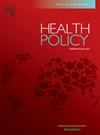COVID-19 期间德国的集权战略:延续还是中断趋势?
IF 3.6
3区 医学
Q1 HEALTH CARE SCIENCES & SERVICES
引用次数: 0
摘要
为应对 COVID-19 大流行病,许多国家在国家政府与地区/地方政府之间分配监管任 务的权力时采用了集中化战略。因此,卫生政策的决策权从地区一级转移到国家一级(决策权的纵向转移)。这种以感染控制为目的的中央集权趋势在德国非常明显。我们对卫生政策监管措施(2018 年 3 月至 2020 年 3 月)进行了定量和定性分析,以调查在 COVID-19 大流行之前,决策权的纵向转移在德国是否已经成为一种趋势,并且超出了感染控制的范围。我们的研究结果表明,在 COVID-19 期间观察到的集中化战略并没有延续这一趋势。在 COVID-19 大流行之前,最重要的是国家层面的权力在政府和非政府机构之间的分配(决策权的横向分配)。这一长期趋势加强了政府机构的决策能力,削弱了非政府机构的决策能力。本文章由计算机程序翻译,如有差异,请以英文原文为准。
German centralization strategy during COVID-19: Continuing or interrupting a trend?
In response to the COVID-19 pandemic, many countries applied centralization strategies to the distribution of power between national government and regional/local governments over responsibility for regulatory tasks. As a result, health-policy decision-making competences were shifted from the regional level to the national level (vertical shift of decision-making competences). This centralization trend for the purpose of infection control is evident in Germany. We conducted a quantitative and qualitative analysis of health-policy regulatory measures (March 2018 to March 2020) in order to investigate whether the vertical shift in decision-making competences was already a trend in Germany before the COVID-19 pandemic and beyond infection control. Our results show that the centralization strategy observed during COVID-19 does not continue a trend. Before the COVID-19 pandemic, what was most important was the distribution of power at national level between government and non-government institutions (horizontal allocation of decision-making competences). This long-term trend strengthens the decision-making competences of government institutions and weakens non-government institutions.
求助全文
通过发布文献求助,成功后即可免费获取论文全文。
去求助
来源期刊

Health Policy
医学-卫生保健
CiteScore
6.40
自引率
6.10%
发文量
157
审稿时长
3-8 weeks
期刊介绍:
Health Policy is intended to be a vehicle for the exploration and discussion of health policy and health system issues and is aimed in particular at enhancing communication between health policy and system researchers, legislators, decision-makers and professionals concerned with developing, implementing, and analysing health policy, health systems and health care reforms, primarily in high-income countries outside the U.S.A.
 求助内容:
求助内容: 应助结果提醒方式:
应助结果提醒方式:


